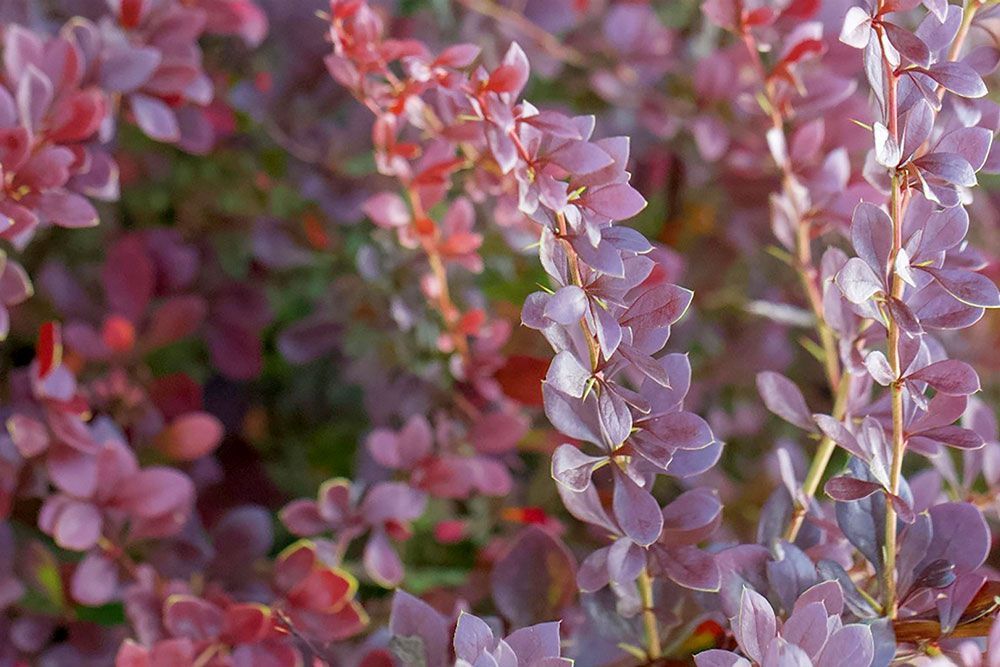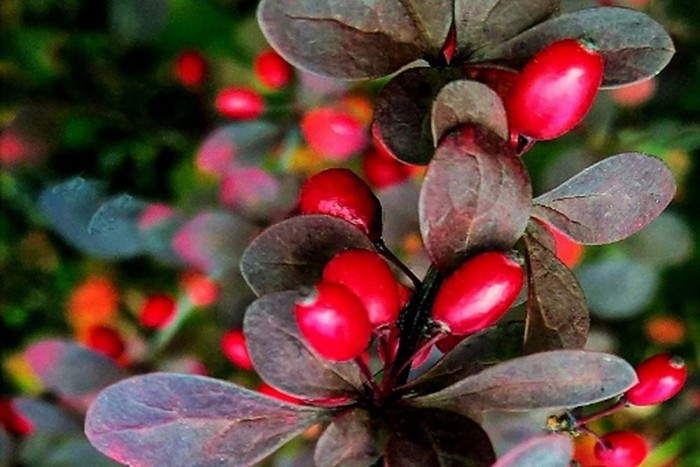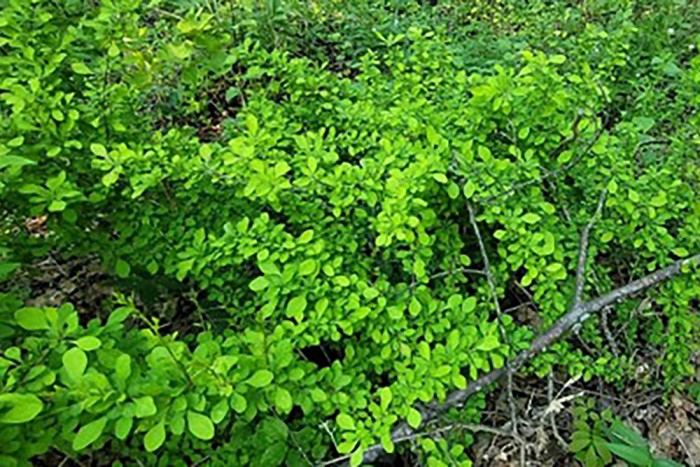Japanese Barberry is tall, colourful and invasive

Tall, colourful Japanese Barberry is invasive plant that poses threats to local ecosystems
By Renee Sandelowsky and Helen Varekamp
Renee Sandelowsky and Helen Varekamp are Bayfield residents and local volunteers. They are writing a monthly series of articles, for the Canadian Coalition for Invasive Plant Regulation, about the benefits of planting native species of plants and removing invasive species. This month (July 2025), their focus is the invasive plant Japanese Barberry – Berberis thunbergii.
Invasive Plant of the Month Feature – Japanese Barberry – Berberis thunbergii
Japanese Barberry has been introduced for garden use, as well as incline stabilization and erosion control. This tall bush grows to be 1 to 1.5 metres in height. It grows in a rounded form and has thorns along its many branches. It comes in different colours such as purple, pink, and lime-green. Barberries are prolific seed producers and have 90 per cent germination rates. The seeds ripen in autumn, persist on the shrub through winter, are carried long distanced by birds, and take root in natural areas. Barberries are adapted to all soil types, can survive in full sun or full shade, and have shown an ability to acidify soil, thereby affecting native habitats.
Since its initial introduction to North America, Japanese Barberry has escaped cultivation and become a problematic invasive plant in many natural areas, particularly woodlands. Japanese Barberry has several traits that contribute to its success as an invader. It forms very dense and persistent infestations because it utilizes multiple reproductive strategies, thrives in a wide variety of habitats, alters soil chemistry, has a longer growing season compared to many native plants and is resistant to deer browsing. One plant can produce up to 35,000 fruits.
Japanese Barberry can also reproduce vegetatively through above-ground and below-ground shoots. Above-ground shoots give the plant its arching form and can produce new roots when they contact the soil.
While this plant has significant wholesale value in the horticulture industry, it becomes extremely costly to remove once established.
- Ecological Impact: This invasive plant can form very dense and persistent infestations, even in shaded conditions, which are particularly problematic in closed canopy forests.
- Economic Impact: Despite its negative impacts, many cultivars of Japanese Barberry remain available for purchase in Canada, even over the Internet through online gardening sites. Japanese Barberry has an extremely high wholesale value in the horticulture industry.
- Societal Impact: Japanese Barberry infestations have been indirectly connected with higher instances of Lyme disease carried by black-legged ticks. Dense growth of Japanese Barberry creates an ideal habitat for deer mice, which are a host for black-legged ticks. This could potentially lead to more cases of Lyme disease and other tick-borne diseases in humans, pets, and livestock.
Thickets of Japanese Barberry can be impenetrable which may limit recreational activities. In addition, the sharp spines could pose a health and safety concern.

How to manage Japanese Barberry
Managing Japanese Barberry is challenging but achievable with persistence and a multi-step approach:
- Manual Removal: For small shrubs and populations, dig up the plants and roots before they set seed, and remove manually. This is most effective when the soil is moist. Use a spade or weed wrench; wear thick gloves and long sleeves to protect against the sharp spines. Do not put the plants or seeds in the compost or municipal green waste.
- Smothering: Another option for small or larger populations is to cut the shrubs down to the ground and cover infested areas with tarps to block sunlight and prevent sprouting.
- Herbicide Treatment: Difficult to reach or large areas may be treated by herbicide, either on foliage or on stems after cutting. Use herbicides only as a last resort, following applicable regulations to minimize environmental harm.
After removal, re-plant the area with regionally appropriate native species of plants. This step is essential to prevent reinfestation and to restore ecosystem health. Native plants will also attract pollinators and wildlife, improving biodiversity in your garden.
A good choice, as an alternative, would be Potentilla, also known as Shrubby Cinquefoil – Dasiphora fruticosa
Learn more and take action
Education is key to combatting invasive plants. Learn to identify invasive species and choose native or non-invasive alternatives for your garden. Focus on managing one or two invasive plants at a time and be patient – successful eradication takes time and persistence.

To learn more, visit:
- Ontario Invasive Plant Council
- Canadian Coalition for Invasive Plant Regulation
- Grow Me Instead Guide
Why should you plant native species of plants?
Why plant an invasive plant when you can plant a native plant species? A native plant is an integral part of the ecosystem. An invasive plant is an aggressive intruder that takes up ecosystem resources and doesn’t give back.
Invasive plants have been introduced to our area from other parts of the world, either on purpose or by accident. They often are of little or no value to insects and other wildlife, while invading natural areas and crowding out native plants.
You might think the beautiful plant in your yard isn’t dangerous. After all, it’s just in your backyard. However, birds carry the seeds into forests and other natural areas and the bush grows out of control. This takes up nutrients and out-competes the native plants that wildlife need for food and shelter. Instead of a Burning Bush plant, for example, consider Chokecherry, Winterberry or Blueberry, to name a few. You will still get the stunning autumn colour, but additionally you will have provided wildlife with berries for food – a definite win-win situation!
Alarmingly, many invasive plants are sold at some local nurseries. Examples include Periwinkle; Burning Bush; Japanese Barberry; and Creeping Jenny. Once these species spread beyond gardens, they join many other established invasives such as Phragmites; Purple Loosestrife; Garlic Mustard; and Common Buckthorn. This degrades our natural landscapes.